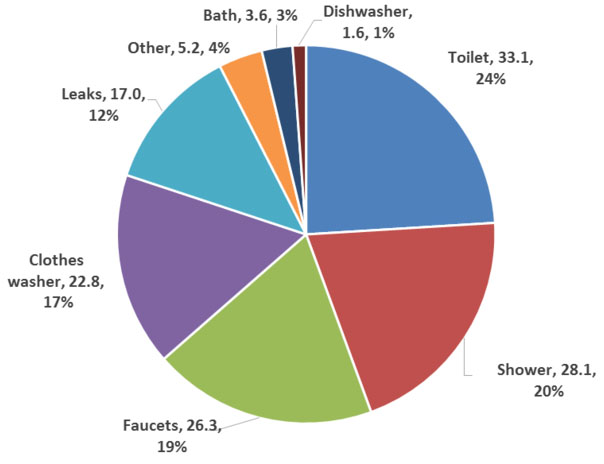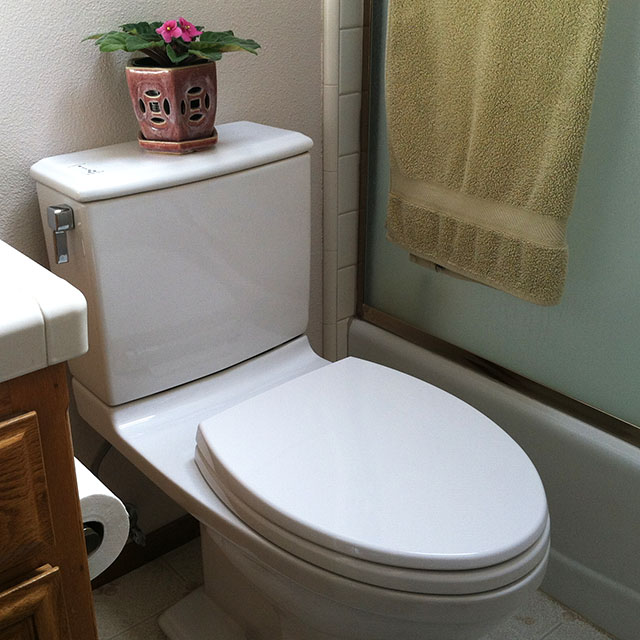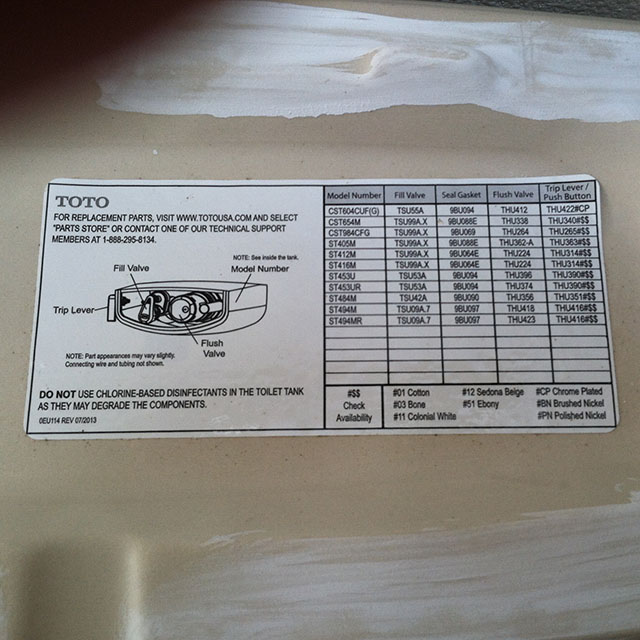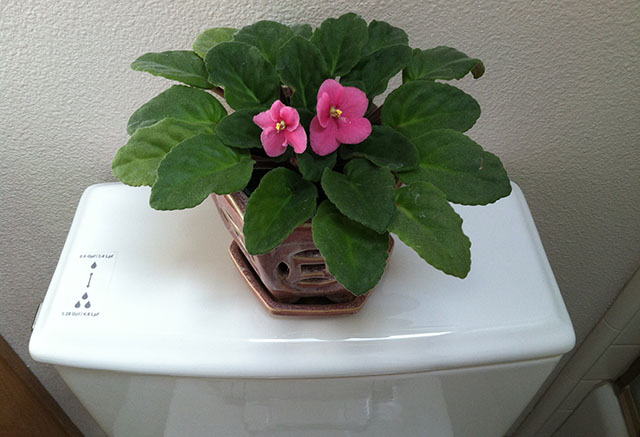What if conserving water was as easy as flushing a toilet? It is if you replace your old water hogging probably leaky toilet with a high-efficiency model.
A toilet replacement project may not be high on your list of priorities, but perhaps it should be.
The first day of spring is just behind us and here on the California Central Coast, a green blanket of grass covers the hillsides and the wildflowers are just beginning to show their colorful faces. It was a good rainy season for us meaning we received about the historical average rainfall for our area.
Yet, I am aware that another drought will occur in the future and that global warming will continue to make many regions like ours hotter and drier putting even more stress on already depleted water supplies.
This may sound weird but I usually have water on my mind more during the rainy season than the dry summer. Last March I wrote a series of posts about water conservation entitled Why is Now a Good Time to Implement Water Saving Ideas?, Making Water Conservation a Way of Life – Indoors, and Making Water Conservation a Way of Life – Outdoors.
This March I decided to tackle the unglamorous topic of high-efficiency toilets because toilets are notorious water wasters. Old toilet models use a whopping 3-8 gallons per flush (GPF) and they are prone to leaking. Also, in the United States, we mostly use potable water, which is water that has been treated to drinking water quality, for flushing toilets.
Toilet efficiency did get a boost when Congress passed the Energy Policy Act of 1992. Most of the law relates to energy but there is a provision to establish the first-ever federal water efficiency standards for plumbing fixtures like toilets, urinals, showerheads, and faucets. Toilets manufactured after 1994 are required to use 1.6 GPF or less.
Some of the early low flow toilets had performance problems that resulted in people flushing toilets twice defeating the purpose of using a water-efficient toilet. Fortunately, toilet designers unleashed their creativity and now 25 years later, high-efficiency toilets get the job done consistently with even less water.

A 2016 Water Resource Foundation study found that each person flushes the toilet on average 5 times a day at home, which represents about 24% of residential indoor water use. (Image showing percentages and gallons – DziegielewskiBA – Wikipedia.)
By replacing your old leaky toilets with high-efficiency models you can reduce the amount of drinking water your household flushes down the toilet, conserve water, and save money on your water/sewer bill.
The balance of this post covers my family’s experience with high-efficiency toilets and provides a list of things to think about before you start your own toilet replacement project.
Deciding to Invest in High-Efficiency Toilets
Our mission to conserve water in our household began shortly after we moved here from Southern California in 2007. Originally, we focused on creating a drought-resistant yard and as our aging appliances needed replacing, we purchased water and energy-
In 2013, when our water district banned outdoor watering with potable water, my spouse and I realized we needed to ramp up our water conservation measures.
One of the things we did was to implement an “if it is yellow, let it mellow” toilet flushing policy. This saved water but it did not seem like a good long-term strategy. Putting bricks in our toilet tanks or installing retrofit kits did not seem like ideal solutions. We also discovered that our toilets were leaking (see below for instructions on how to check for leaks).
My family strongly objected to my suggestion that we consider switching to composting toilets and to be honest I was not ready to make that leap either.
After I had thoroughly researched high-efficiency toilets, we decided to replace our three old leaky toilets. It was a considerable financial investment but the water savings over the past 4 years and 4 months have been and will continue to be significant for years to come.
Our High-Efficiency Toilet Replacement Project
We opted for a Toto Connelly dual flush model with a lever versus a button. The toilet user pushes the lever one way to flush with 0.9 gallons of water and the other way to flush with 1.28 gallons of water (there is a label on top of the toilet tank). The lever design prevents over flushing.

High-Efficiency Toilet 
Parts List inside the Lid 
Toilet Bowl and Seat
Our cost per toilet in 2014 was $808 less a $25 rebate from our water company for a net cost of $783. This included the toilet, a toilet seat, small parts needed for installation, sales tax, installation, and disposing of the old toilet.
Performance
High-efficiency toilets use gravity-assisted technology to flush the contents down the toilet with substantially less water than older models. Our toilets perform adequately and consistently. It does help to toss toilet paper in the deepest part of the bowl but this is an easy habit to learn.
The extremely hard water our household receives is tough on plumbing fixtures including faucets and toilet guts. One of our toilets required a replacement part a few months ago. Even without hard water, you should expect that any kind of toilet might need maintenance from time to time.
Cleaning
A special material coats the toilet bowls to keep them clean with less water but skid marks do occur occasionally. Toilet cleaner manufacturers have programmed us to believe that our toilets should always be sparkling clean so if you feel uncomfortable with skid marks you can easily clean them off with toilet paper, a water spray bottle, or a sponge.
To protect the special finish in the toilet bowl manufacturers recommend that you do not use abrasive cleaners or toilet brushes (plastic is okay) and do not put automatic toilet bowl cleaning disks inside the bowl.
For cleaning the toilets, I don rubber gloves, squirt toilet bowl cleaner in the bowl, and use our designated toilet cleaning sponge to clean it. I find this is easier and quicker than using a toilet brush.
Payback Period
A payback period is the length of time it takes an investment to recover its initial cost either in profits or savings.
For reasons, I do not fully understand there seems to be an expectation of a payback period for some home improvement projects like installing solar panels or high-efficiency toilets but not for others such as remodeling a kitchen or bathroom.
I am willing to play along if it helps you with making a decision to replace your old toilets. My family of four refused to participate in a toilet flushing study so I used five flushes per day in
The total cost of the toilet installation was $2,349 divided by an estimated annual water savings of 502 gallons = a payback period of 4.7 years.
Our toilets are dual flush models that use less water overall so we have probably already passed the payback threshold.
You can do your own analysis using the Excel spreadsheet I created for our project.
Tips for High-Efficiency Toilet Replacement Projects
Whether you have one toilet to replace or several, buying and installing a high-efficiency toilet is not an inexpensive project so you will want a toilet that works and will last for many years. Here are a few things to consider for your own project.
- Do your homework so you can select a model that is suitable for your household. Read reviews and watch videos made by manufacturers and high-efficiency toilet fans.
- Beware of unnecessary bells and whistles. Do you really need a toilet with a sensor that flushes the toilet when you pass your hand over it?
- Do not buy a cheap model. In the world of toilets, you get what you pay for. There is a wide range of high-quality toilets on the market so chances are you can find one that fits in your budget.
- Do not buy a toilet online. Toilets are made of vitreous china and are prone to getting hairline cracks during shipping. Imagine the hassle of shipping a toilet back to the manufacturer or even worse not realizing that it will leak.
- Unless you are a plumber, hire a professional with experience installing high-efficiency toilets.
- Contact your water company to find out if they are offering rebates (every little bit helps).
Pay It Forward
When you sell your home, include your high-efficiency toilets as a
If you live in a municipality (I do) that requires new homeowners to certify that their home is retrofitted with high-efficiency plumbing fixtures you will have saved potential buyers the inconvenience of doing it themselves while they are trying to move into their new home.

After reading this post, I hope you feel more informed about high-efficiency toilets and are at least considering replacing your old water guzzling and possibly leaky toilets. Once you do, you will be conserving water every time you flush your toilet.
I realize that this may not be a good time for you to embark on a high-efficiency toilet replacement project for a variety of reasons. If that is the case, there are plenty of other actions you can take to conserve water at home. The posts below in the resources section provide a variety of ideas including actions that are easy and low or no cost.
Featured Image at Top: Low water levels at Lake Mead, which is a man-made lake on the Colorado River – photo credit John Locher/Associated Press. When full, Lake Mead is the largest water reservoir in the United States. Click here to read the article that accompanies the photo.
How to Check Your Toilet for Leaks
Leaking toilets waste water and money. Here are two easy methods for determining if a toilet is leaking.
- Turn off the water valve behind the toilet. After an hour or so, check the level of the water in the toilet bowl. If it is lower or the bowl is empty your toilet leaks.
- Put 10-15 drops of food coloring in the toilet tank. After 20 or 30 minutes, if you see color in the toilet bowl your toilet leaks.
Related Posts
- California Drought – You Cannot Drink Denial
- Clean Water Laws – Prior to
Safe Drinking Water Act of 1974 - Drought in a Small Town – Saving Water before the Drought
- Drought in a Small Town – Saving Water during the Drought
- Making Water Conservation a Way of Life – Indoors
- Making Water Conservation a Way of Life – Outdoors
- Safe Drinking Water Act of 1974 and Beyond
- Safe Drinking Water – What Can We Do?
- What Good is a Rain Barrel during a Drought?
- Why is Now a Good Time to Implement Water Saving Ideas?
Resources
- January 2019 Statewide Conservation Data – California Water Boards (snapshot of water use in California)
- Residential End Uses of Water, Version 2 – by The Water Research Foundation, 2016 (scroll down the page and click on the 4/7/16 PDF for a free executive summary)
- Residential Water Use in the U.S. and Canada – Wikipedia
- The Energy Policy Act: Assessing Its Impact on Utilities – by Amy Vickers, Journal (American Water Works Association) Vol. 85, No. 8, Conservation (August 1993), pp. 56-62 (I got this highlighted article from cvillewater.info. It gives an interesting overview of the then new water efficiency standards for plumbing fixtures.)
- Water Sense® Labeled Toilets Fact Sheet – U.S. Environmental Protection Agency
- Water Use in the United States – U.S. Geological Survey (big picture view of the water situation in the U.S.)

